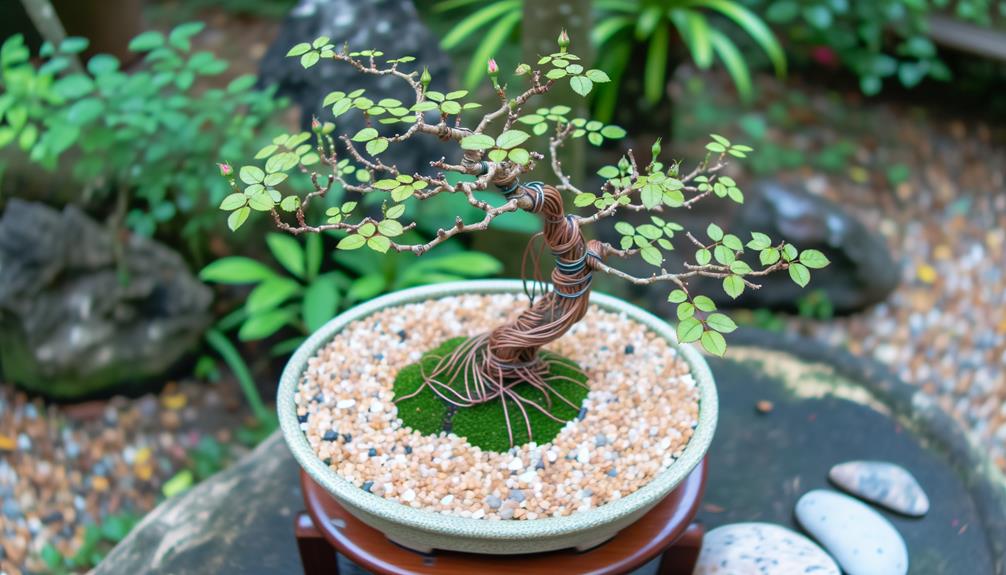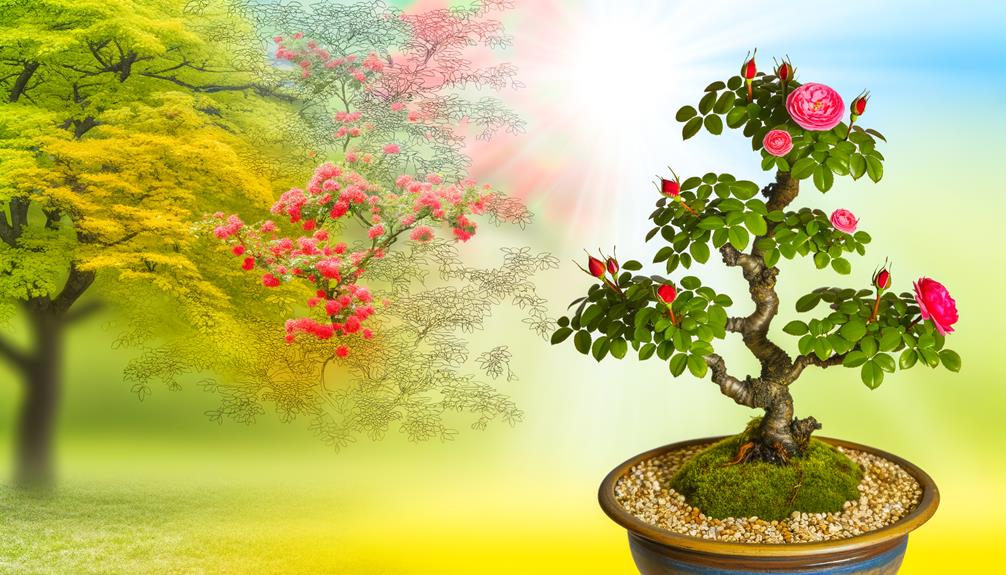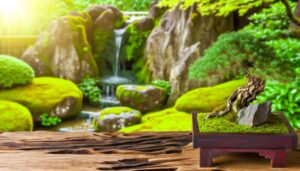5 Steps for You to Bonsai a Rose Bush: A Beginner’s Guide
Yes, you can bonsai a rose bush. It involves selecting suitable species, such as miniature or dwarf varieties, and understanding their growth habits.
Key steps include regular root pruning, precision trimming of branches, and controlled watering to maintain a compact, aesthetically pleasing form. Guarantee proper soil composition with akadama, pumice, and lava rock, and provide 4-6 hours of direct sunlight daily.
Sterilize tools to prevent pathogen transmission and use mycorrhizal fungi solutions for robust root health. By following specific horticultural techniques, you can cultivate a stunning bonsai rose bush.
Explore further to master advanced pruning and wiring techniques.

Key Takeaways
- Yes, you can bonsai a rose bush by selecting miniature or dwarf rose varieties.
- Choose species with small leaves, compact growth, and good pruning tolerance.
- Ensure proper soil composition with akadama, pumice, and lava rock for drainage.
- Prune roots and branches regularly to shape and maintain the bonsai form.
- Provide 4-6 hours of direct sunlight daily and monitor watering needs seasonally.
Understanding Bonsai Basics

Bonsai, the ancient Japanese art form that involves cultivating miniature trees, requires a thorough understanding of horticultural principles and meticulous techniques to successfully miniaturize a rose bush. Essential components include root pruning, branch trimming, and controlled watering.
Root pruning involves severing taproots and fine roots to restrict growth. Branch trimming necessitates strategic cuts to shape and balance the structure, encouraging lateral growth. Controlled watering is imperative to prevent root rot and maintain best moisture levels.
Additionally, soil composition is crucial; a well-draining bonsai mix typically includes akadama, pumice, and lava rock. Proper sunlight exposure, ideally 4-6 hours of direct light, is also significant for photosynthesis. Mastery of these techniques ensures the health and aesthetics of the bonsai rose bush.
Choosing the Right Rose
When selecting a rose species for bonsai, it is essential to contemplate both suitability and growth habit. Species with smaller leaves and compact growth patterns, such as Rosa chinensis 'Minima', are preferable due to their manageable size and aesthetic appeal.
Additionally, understanding the plant's innate growth habit, including its ramification potential and root structure, is vital for successful bonsai cultivation.
Rose Species Suitability
Selecting the appropriate rose species is crucial for successful bonsai cultivation, as it involves considering factors such as growth habits, hardiness, and flower characteristics. Key attributes to evaluate include the species' tolerance to pruning, adaptability to container growth, and resistance to pests and diseases. Miniature and dwarf rose varieties are particularly suitable due to their compact size and manageable growth patterns. Below is a table summarizing three potential rose species for bonsai:
| Species | Hardiness Zone | Flower Size |
|---|---|---|
| Rosa 'Baby Faurax' | 5-9 | Small |
| Rosa 'Fairy' | 4-9 | Medium |
| Rosa 'Petite Pink' | 6-9 | Tiny |
Choosing the right species ensures the bonsai will thrive under the specific conditions required for best growth and aesthetic appeal.
Growth Habit Considerations
Understanding the growth habits of rose species is vital for determining their suitability for bonsai cultivation. This involves evaluating factors such as root structure, branching patterns, and overall size potential.
When selecting a rose bush for bonsai, consider the following attributes:
- Root Structure: Opt for species with fibrous root systems, which adapt better to shallow bonsai containers.
- Branching Patterns: Choose varieties with naturally small, intricate branching to facilitate traditional bonsai aesthetics.
- Size Potential: Select dwarf or miniature rose species to ensure manageable growth within the constraints of a bonsai pot.
- Disease Resistance: Prefer cultivars with inherent resistance to common rose diseases to minimize maintenance.
- Flowering Characteristics: Confirm the species has a consistent blooming cycle that complements the bonsai form.
These factors are crucial for successful bonsai cultivation of rose bushes.
Preparing Your Rose Bush

Proper preparation of your rose bush is essential for successful bonsai cultivation and involves specific steps to guarantee ideal growth and health. Begin by selecting a healthy specimen with robust root systems and minimal signs of disease. Sterilize your tools to prevent pathogen transmission.
Gently remove the rose bush from its container, taking care not to damage the root ball. Conduct a root inspection, trimming any dead or diseased roots. Soak the roots in a mycorrhizal fungi solution to promote nutrient absorption.
Prepare a bonsai pot with well-draining soil, incorporating organic matter to enhance fertility. Position the rose bush in the pot, ensuring proper root spread. Anchor the plant securely, then water thoroughly to settle the soil.
Pruning Techniques
Pruning techniques for bonsai rose bushes require precision and the correct set of essential pruning tools, including bypass pruners and fine-tip scissors.
Shaping primary branches necessitates strategic cuts to establish the desired form and enhance structural integrity.
Managing new growth involves removing excess shoots and fostering balanced distribution of foliage for best health and aesthetics.
Essential Pruning Tools
Selecting the appropriate pruning tools is crucial for executing precise and effective cuts on a rose bush intended for bonsai cultivation. Pruning tools must be sharp and well-maintained to achieve clean cuts, reducing the risk of disease and promoting healthy growth.
Essential tools include:
- Bypass Pruners: Ideal for cutting live branches due to their scissor-like action.
- Lopping Shears: Provide leverage for cutting thicker branches.
- Pruning Saws: Necessary for removing larger, woody stems.
- Sharpening Stones: Maintain blade sharpness for best performance.
- Disinfecting Solutions: Prevent cross-contamination between cuts.
Utilizing these tools correctly ensures the structural integrity and aesthetic appeal of the bonsai rose bush.
Shaping Primary Branches
Establishing the foundational structure of a bonsai rose bush involves strategic pruning of primary branches to direct growth and enhance the overall aesthetic form. Begin by identifying the primary branches that will form the main framework. Utilize concave cutters to make clean cuts at a 45-degree angle, promoting best healing. Prune branches growing inward or crossing others to prevent congestion and enhance air circulation.
| Pruning Technique | Purpose |
|---|---|
| Concave Cutting | Promotes smooth healing and reduces scarring |
| 45-Degree Angle Cuts | Encourages new growth in the desired direction |
| Removing Inward Branches | Prevents overcrowding and improves airflow |
Carefully monitor the plant for signs of stress, ensuring ideal conditions for recovery.
Managing New Growth
To guarantee the bonsai rose bush maintains its desired shape and health, it is essential to implement precise pruning techniques for managing new growth. Regular pruning not only controls the size but also encourages optimal flowering and robust health. Employ sharp, sterilized pruning shears to minimize tissue damage and prevent pathogenic infections. Focus on removing leggy growth, which detracts from the bonsai's compact form.
Pinch back soft new shoots: This limits vertical growth and promotes lateral branching.
Trim dead or diseased wood: Reduces the risk of infection.
Prune crossing branches: Prevents rubbing and subsequent wounds.
Thin out dense areas: Enhances air circulation and light penetration.
Cut back to an outward-facing bud: Encourages balanced, radial growth.
These practices ensure a well-structured and healthy bonsai rose bush.
Wiring and Shaping

When considering the intricate process of wiring and shaping a rose bush for bonsai, precision and understanding of the plant's growth patterns are paramount. Begin by selecting malleable branches; wire them using anodized aluminum or annealed copper, ensuring the wire is 1/3 the thickness of the branch.
Coil the wire at a 45-degree angle, avoiding tight wraps that could damage the cambium layer. Shape branches gradually, respecting the plant's natural growth direction to prevent undue stress. Regularly monitor and adjust the wiring to accommodate growth and avoid girdling.
Pruning should be meticulous, focusing on nodes and internodes to achieve desired aesthetics. Employing these techniques will enhance structural integrity and promote a visually appealing bonsai form.
Potting and Soil Requirements
Selecting the suitable pot for a rose bush bonsai is crucial, as it must provide sufficient drainage while accommodating the plant's root system.
The perfect soil mix should be well-draining and nutrient-rich, typically comprising a balanced combination of akadama, pumice, and organic compost.
Ensuring the proper pot and soil composition will promote healthy growth and facilitate best water retention and aeration.
Choosing Right Pot
Utilizing a well-draining, bonsai-specific pot is necessary for maintaining the health and growth of a bonsai rose bush, as it guarantees proper root aeration and prevents waterlogging. Selecting the appropriate pot involves considering several important factors:
- Material: Opt for ceramic or clay pots as they provide ideal breathability.
- Size: Make sure the pot size accommodates root expansion without causing constraint.
- Drainage Holes: Multiple drainage holes are essential to prevent root rot.
- Shape: Shallow pots are preferable as they align with bonsai aesthetics and root pruning practices.
- Color: Choose subdued colors that complement the rose bush's foliage and flowers.
These elements collectively help the bonsai rose bush thrive, aligning with horticultural best practices and aesthetic principles.
Ideal Soil Mix
A best soil mix for a bonsai rose bush must combine organic matter, such as pine bark or compost, with inorganic elements like akadama, pumice, and lava rock to guarantee proper drainage and nutrient retention.
The organic components increase moisture retention and supply essential nutrients, while the inorganic elements optimize adequate aeration and prevent root rot.
A recommended ratio is 50% akadama, 25% pumice, and 25% lava rock, with a modest inclusion of organic material. This composition provides an ideal balance, fostering root health and facilitating nutrient uptake.
Regularly monitor pH levels, aiming for a slightly acidic range of 6.0 to 6.5, as roses thrive in such conditions. Properly preparing this mix is essential for the successful cultivation of a bonsai rose bush.
Watering and Fertilizing

How does one secure peak hydration and nutrient delivery to a bonsai rose bush to promote vigorous growth and flowering? Precise watering and fertilizing practices are paramount. Guarantee soil moisture consistency while avoiding waterlogging. Implement a fertilizer regimen rich in essential macro and micronutrients.
Here are key recommendations:
- Watering Frequency: Water daily in summer; reduce in winter.
- Water Quality: Utilize rainwater or distilled water to evade mineral buildup.
- Fertilizer Type: Employ a balanced, slow-release fertilizer with N-P-K ratio tailored for roses.
- Application Timing: Fertilize during the active growing season, from spring to early autumn.
- Soil pH: Maintain slightly acidic soil (pH 6.0-6.5) to optimize nutrient uptake.
Adhering to these guidelines secures robust health and prolific blooming of your bonsai rose bush.
Pest and Disease Management
Effective pest and disease management for bonsai rose bushes involves identifying common threats such as aphids, spider mites, powdery mildew, and black spot, and implementing targeted control measures.
Regular monitoring is essential, utilizing magnification tools to detect early-stage infestations. Aphids and spider mites can be managed through insecticidal soap or neem oil applications, ensuring thorough coverage of foliage.
For fungal infections like powdery mildew and black spot, a fungicidal spray containing myclobutanil or sulfur is advised. Pruning infected leaves and ensuring proper air circulation reduces disease susceptibility.
Integrated Pest Management (IPM) strategies, including biological controls like ladybugs for aphid predation and maintaining ideal humidity levels, further enhance the plant's resistance to pests and diseases.
Seasonal Care Tips

Seasonal care for bonsai rose bushes involves adjusting watering schedules, fertilization routines, and pruning techniques to align with the plant's growth cycles and environmental conditions. During spring, increased daylight and rising temperatures necessitate more frequent watering and the application of balanced fertilizers to support vigorous growth.
Summer heat requires regular hydration and shading to prevent desiccation. In autumn, gradual reduction in watering and a shift to phosphorus-rich fertilizers promote root development and hardening. Winter care involves minimizing watering, protecting roots from frost, and reducing pruning to avoid stressing the plant.
Key Seasonal Care Tips:
- Increase watering frequency during spring and summer.
- Apply balanced fertilizers in spring and phosphorus-rich fertilizers in autumn.
- Provide shade during intense summer heat.
- Reduce watering and pruning in winter.
- Protect roots from frost damage.
Common Challenges and Solutions
Despite attentive seasonal care, bonsai rose bushes often face common challenges such as pest infestations, fungal diseases, and improper soil drainage, which can hinder their growth and health.
Aphids and spider mites are widespread pests; apply insecticidal soap or neem oil bi-weekly to reduce infestations.
Fungal diseases like powdery mildew and black spot require a fungicide regimen; ensure sufficient airflow around foliage to prevent moisture buildup.
Inadequate soil drainage can result in root rot; utilize a well-draining bonsai soil mix, incorporating akadama, pumice, and lava rock.
Regularly check soil moisture levels, avoiding saturation by letting the substrate partially dry between waterings.
Implementing these strategies will boost the strength and aesthetic appeal of your bonsai rose bush.
Conclusion
Mastering the art of transforming a standard rose bush into a bonsai is not merely an exercise in horticulture but a profound exploration of botanical miniaturization.
The precision in pruning, meticulous wiring, and exacting care routines are paramount. This endeavor demands a Herculean commitment to detail, akin to the precision of a neurosurgeon.
By adhering to these rigorous methodologies, one can cultivate a rose bonsai that is not only a horticultural marvel but a demonstration of the zenith of botanical artistry.






